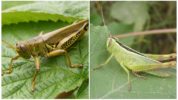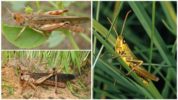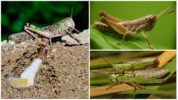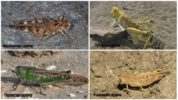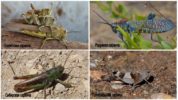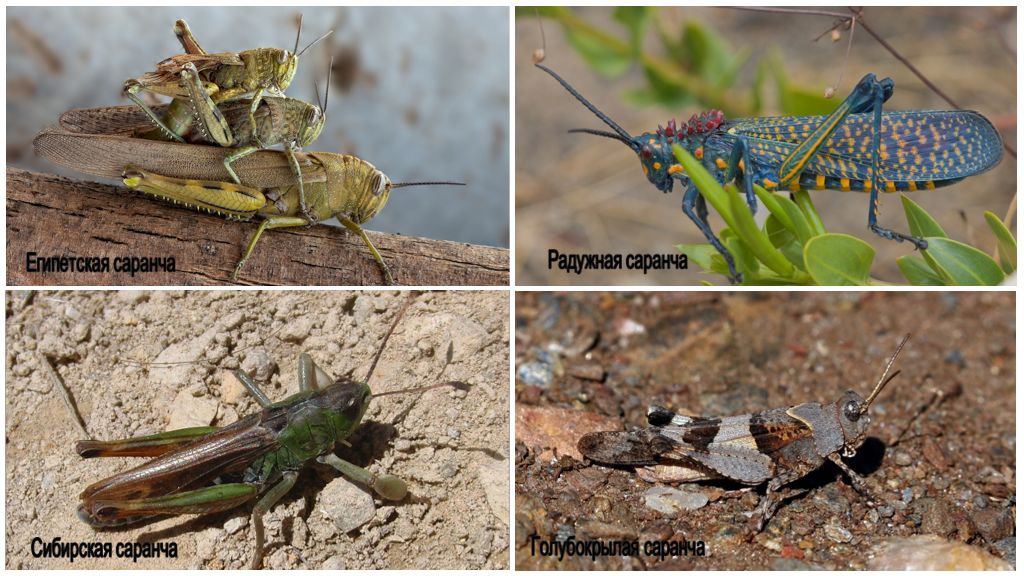- Locust
- Locust feeding
- Locust
- Locust species
- Locust species
Pests of agriculture there are so many. Each specializes in a certain type of food: leaves, grass, fruits, vegetables. The locust insect eats all the greens that it encounters along the way, and even grabs the cereal crops. There is even such a saying among the people: "Flew like locusts." Indeed, these insects fly in huge swarms and destroy everything in their path, leaving nothing defeated.
Appearance
The locust insect, also called acrida, belongs to the family of real locusts, the order of orthoptera. The name came from the Turkic languages, which means “yellow” in translation. But the color of the locust can vary from grayish to olive-brown, depending on the habitat and age of the locust.
Interesting!
Locust stains mask the insect. It differs even among the next of kin and depends not only on the species, but also on the environment, nutrition, climate humidity.
Locusts have a body length of 1 to 20 cm. The head is large with a powerful jaw apparatus and large eyes on the sides. The lower wings of a transparent shade of light green are covered with hard elytra. Females are larger than males. Locust females have a short, sharp ovipositor. Just as a locust male makes sounds by the friction of special notches located on the hips of the hind legs about a thickening on the wings.
Differences from nearby views
If you look at the locust photo, you can see that the insect looks very similar to a grasshopper, but they belong to a different order. Grasshoppers - to grasshoppers and Long-billed, and locusts - to locusts and Short-billed. The difference also lies in the fact that the pest has shorter and less powerful limbs. There are differences in lifestyle:
- grasshoppers - predators, locusts - herbivores;
- long-nosed - nocturnal insects, short-nosed - daytime;
- grasshoppers lay eggs on plants or under the bark of trees, acrid plants - in the ground.
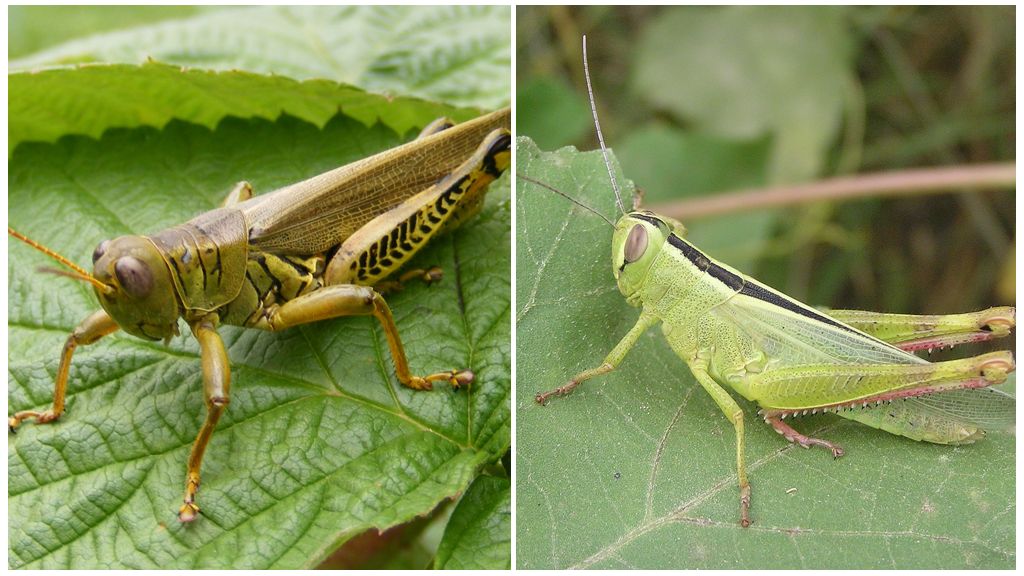
On a note!
Mantis also similar to a grasshopper, and therefore to a locust. But this is not so. The grasshopper has strong hind limbs to run and jump as far as possible, while the mantis has stronger front legs, as its goal is to capture and hold prey. Outwardly, it looks more elongated and elegant. The eyes are located in front, at the grasshopper on the sides of the head.
Locust Phases
Locusts have two stages: solitary and herd. Loners (filly) are divided into males and females and lead an inactive lifestyle. For their life they can eat no more than 300 grams of green mass. They are considered harmless as long as there is food. As soon as the locust begins to feel a shortage of food, it postpones the “marching offspring”, which subsequently forms flocks. Thus, they pass into the herd individual. The sizes of this brood are larger, the wings are longer, they are more active, have the same color, gender separation is almost absent.
Interesting!
Flocks of herd acridas can number up to hundreds of millions of insects, forming clouds of several thousand square meters. Locusts are very voracious and eat greens and cereals found along the way. In flight it makes a noise that can be mistaken for thunder. Flocks are mobile, can cover distances of up to 200 km per day. There are recorded cases of locusts flying across the ocean at a distance of 6000 km.
Nutrition
The locust insect eats a variety of greens, including cereals. She eats as much food a day as she weighs. The offspring of one female locust eats up an amount of grass equal in weight to the food of two sheep. Everything that comes in the way of a hungry flock - meadows, fields, gardens, forests, is destroyed in a matter of hours. Occasionally, orchards and vineyards are attacked. The berry is eaten by locusts completely with bark and fruit. With a shortage of food, thatched roofs and weaker members of the flock go to food.
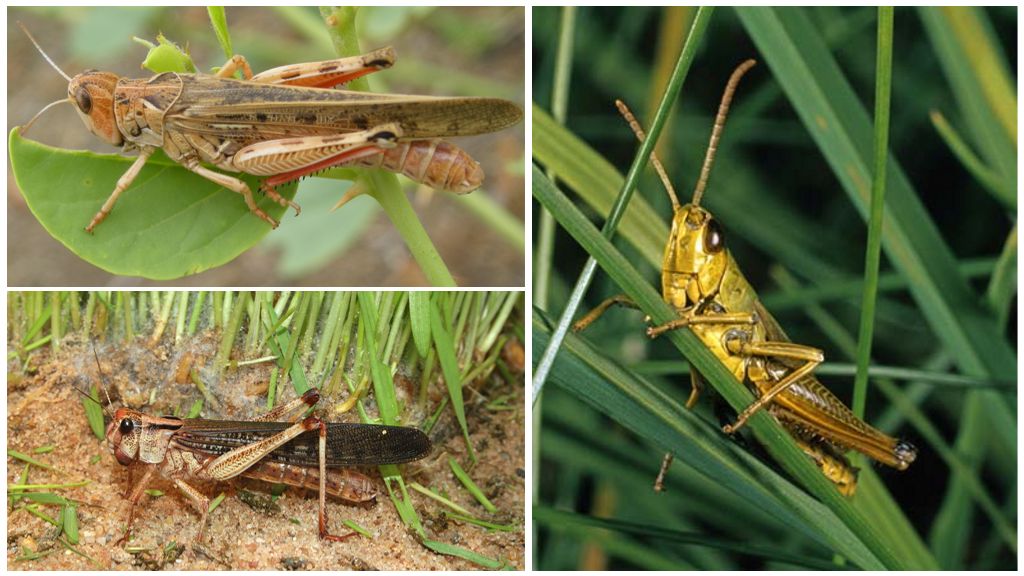
Breeding
Love games locusts start males. They secrete a special enzyme that is able to attract females. Jumping onto the female, the male lays a spermatophore at the base of the female’s ovipositor. This process can last up to 14 hours. After fertilization, the female locust lays eggs in the ground or on fallen leaves, enveloping them with a special liquid that hardens and hardens. Thus, the clutch receives protection during the entire period of maturation of the eggs.
Each locust cocoon contains between 50 and 150 eggs. The female lays from 6 to 12 clutches for life. Up to 2000 cocoons can be counted on one square meter. Locust offspring go through three stages of development: an egg, a larva, an adult. After the winter, larvae emerge from the eggs similar to an adult locust insect only without wings.
Forty days after five molts, a full-fledged locust individual develops from the larva, capable of producing new offspring. The life span of the pest ranges from 8 months to 2 years.
On a note!
In warmer regions and subtropics, locusts develop year-round. Already after 14-16 days a new generation appears, ready to actively move and reproduce.
Locust Habitats
About 12,000 species of locust insects are known. They can be found everywhere except Antarctica. Some insects love the heat and dry climate, so they often settle in semi-deserts and steppes. Steppe locusts live in European, Asian and North African countries. Border areas - Indo-Malaysia, New Zealand, Madagascar, Sahara - everywhere you can see gluttonous acrid. Others settle around water bodies in areas covered by dense, lush vegetation.

On a note!
In Russia, 600 species of insects are found. Their ranges are in Kazakhstan, Siberia, the Amu Darya river basin, near the North Caspian and in Dagestan. In the northern regions, you can also find this formidable pest, but because of the cold climate, their number is not so large.
Historical background on locust infestations
Over the entire period of the existence of mankind, various territories have been repeatedly attacked by acrid. For the first time such a tragic event in the history of ancient Russia is mentioned in the annals of 1008. They caused significant damage to crops, causing people to experience hunger. Such raids were repeated more than once. Acrid flies on Russian lands in the XI-XVII centuries.
On the territory of modern Ukraine there was an invasion of pests in 1824. Alexander Sergeyevich Pushkin was part of the detachment, which was sent to fight this natural disaster. Here is what he wrote as a report:
- May 23 - flew, flew;
- May 24 - and sat down;
- May 25 - sat, sat;
- May 26 - ate everything;
- May 27 - flew away again.
On a note!
In the end of the 18th century, a locust attack in America (Texas) and in the territory located west of it resulted in a huge disaster. Having devastated a huge area, the flock disappeared as quickly as it appeared. In the modern world, crops and vegetation continue to suffer from raids of voracious locusts everywhere, especially in Africa.
Insect species
There are many varieties of locusts. It is impossible to list all. Some of them include:
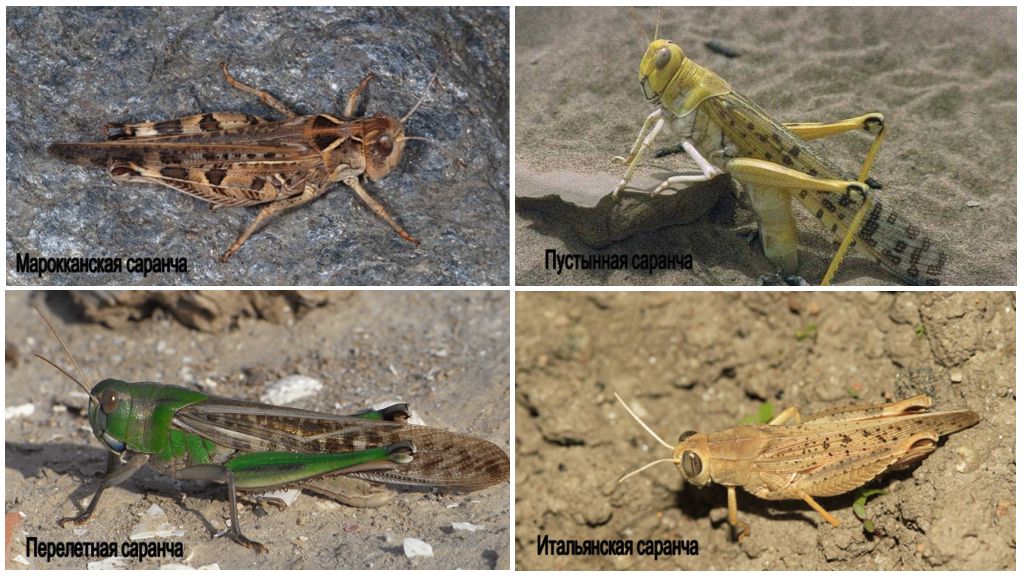
- Moroccan (Dociostaurus maroccanus). Size up to 2 centimeters. Color - reddish brown with small dark spots. It has a fancy pattern on the back in the form of a bright cross.The small size of the locust does not protect crops from total destruction when a whole flock flies. Colossal damage to the lands. For living, locusts have chosen Africa, Central Asia, Egypt, Libya, Algeria, Morocco. Can be found in European countries.
- Deserted. (Schistocerca gregaria). Locusts are large in size. The length of the body of a dirty yellow locust can reach 8 cm. On the wings of brown there are a large number of veins. They live in tropical and subtropical countries.
- Overflight. (Locusta migratoria). It is also called Asian. The body has a length of 3.5 to 6 cm. The color is: green, brown, gray and yellow. Colorless wings are smoky. Black veins are noticeable on them. Locust chose Asian, European, African countries for living. This species can be found in southern and Siberian Russian cities, the Caucasus, and Kazakhstan.
- Italian (Calliptamus italicus). Locusts are small in body size, and wings are powerful, well developed. Color shades - red, brick, brown, brown, slightly pronounced pink tones. On the wings, longitudinal bright stripes and spots are visible. Habitat - Asia, Mediterranean.
- Egyptian. (Anacridium aegyptium). The female locust is large in size. In males - they are almost 1.5-2 times smaller. The place of residence was chosen by European countries. The color shades are discreet: gray, light brown, greenish-olive. A characteristic feature of the Egyptian locust is the strips of white and black that are present on the eyes. Representatives of this species are often found in the East, in Europe, in the northern part of Africa.
- Rainbow. (Phymateus saxosus). There is a very poisonous bright locust in Madagascar. The length of her beautiful, iridescent body with all the colors of the rainbow is about 7 cm. She chooses the leaves of different trees, including euphorbia, whose juice is poisonous.
- Siberian. (Gomphocerus sibiricus). A distinctive feature is the small size of the body (up to 2.5 cm). The color is brown-brown, olive, gray-green. Widely settled in the Caucasus Mountains and settlements of Central Asia. Can be found in China, Kazakhstan. Cereals and hay meadows cause significant harm.
- Blue-winged. (Oedipoda caerulescens). Locusts are very beautiful, body sizes are small (up to 3 cm). The graceful wings are distinguished by a beautiful saturated blue color, but at the base it becomes much paler, almost completely losing its color. Their surface is decorated with a beautiful pattern consisting of thin black stripes. Locusts settled in the steppes and forest-steppes of European and Asian settlements, it can be found in the Caucasus, western Siberia, on Chinese lands.
Interesting!
A locust flock can have about a billion individuals, and the area occupied by it is more than 1 thousand sq. M. The creaky sounds resulting from the friction of the wings look like thunder.
